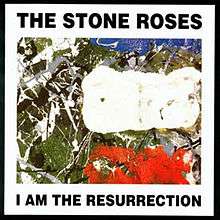I Am the Resurrection
| "I Am the Resurrection" | ||||
|---|---|---|---|---|
 | ||||
| Single by The Stone Roses | ||||
| from the album The Stone Roses | ||||
| A-side | I Am The Resurrection (remix) | |||
| B-side | I Am The Resurrection (dub) | |||
| Released | 30 March 1992 | |||
| Format | ||||
| Recorded | 1989 | |||
| Genre | Madchester[1][2] | |||
| Length | 8:13 | |||
| Label | Silvertone | |||
| Writer(s) | Ian Brown, John Squire | |||
| Producer(s) | John Leckie | |||
| The Stone Roses singles chronology | ||||
| ||||
"I Am the Resurrection" is a song by the Stone Roses and the final song on the UK version of their debut album.
The last four minutes of the song is an instrumental outro. The single was released on 30 March 1992, and reached number 33 on the UK Singles Chart.[3] It was the second of two singles released from their début album while the band were estranged from their label Silvertone.
The track's title and its placing as the final song on the album is believed to have influenced the title of their long-awaited follow-up album, Second Coming, which was released five years later.
Q magazine placed it at number 10 in its list of the 100 Greatest Guitar Tracks.[4]
NME magazine placed "I Am the Resurrection" at number 8 in its list of the 50 Greatest Indie Anthems Ever. NME also placed it at number 100 in its list of the 500 Greatest Songs of All Time.[5]
Originally, the 12" exclusively contained the 8:13 long "Extended 16:9 Ratio Club Mix". Other versions were considerably shorter.
Artwork
John Squire designed the "I Am the Resurrection" cover, (an up-close shot from the cover of the first album) continuing the Jackson Pollock-influenced theme of singles from The Stone Roses.
Track listing
- 7" vinyl (Silvertone ORE 40)
Cassette (Silvertone ORE 40C)
- I Am the Resurrection (Pan and Scan Radio Version) (3:45)
- I Am the Resurrection (Highly Resurrected Dub) (3:30)
- 12" vinyl (Silvertone ORE T 40)
- I Am the Resurrection (Extended 16:9 Ratio Club Mix) (8:22)
- I Am the Resurrection (Original LP version) (8:12)
- Fools Gold (Bottom Won Mix) (6:59)
- CD (Silvertone ORE CD 40)
- I Am the Resurrection (Pan and Scan Radio Version) (3:45)
- I Am the Resurrection (5:3 Stoned Out Club Mix) (5:40)
- I Am the Resurrection (Original LP version) (8:12)
- Fools Gold (Bottom Won Mix) (6:59)
Religious and Messianic language
Biblical scholar James Crossley has noted the biblical language throughout the song where the singer takes on the role of a Christ-like or God-like figure ("I am the resurrection and I am the life"). In addition to the title alluding to John 11, he argues that there are references to stubbornness and repentance found in the prophetic literature of the Old Testament (which repeatedly uses the language of "turning" to God) and persistence and redemption in the New Testament which uses the language of knocking at doors (e.g. Luke 11.5-10; Luke 13.23-27). The song therefore partly functions as "a story of God and Israel/humanity in the Bible" but now "applied to a human relationship".[6]
Cover versions
Codeine Velvet Club included a cover version as a bonus track on their 2010 debut album.
In 2014, Merrymouth, a folk band led by Ocean Colour Scene singer/songwriter Simon Fowler, and friend of the band, recorded the song on their second album Wenlock Hill.
Personnel
- Ian Brown – vocals
- John Squire – guitars
- Mani – bass
- Reni – drums and backing vocals
- I Am The Resurrection remixed by Simon Harris
- Fools Gold remixed by A Guy Called Gerald
References
- ↑ Haslam, Dave (2000). Manchester, England: The Story of the Pop Cult City. Fourth Estate. p. 10. ISBN 978-1-8411-5146-5.
The sights and sounds of Madchester – from the thrilling, rolling drum beats of the Stone Roses' celebratory 'I Am The Resurrection', to Central Station's big colour sleeve and poster designs – were qualitatively different to old Manchester.
- ↑ The Stone Roses: I Am the Resurrection at the Wayback Machine (archived 16 May 2010). XFM.
- ↑ "Stone Roses". Official Charts Company. Retrieved 2 March 2013.
- ↑ "Q Magazine – 100 Greatest Guitar Tracks Ever!". Q. Rocklist.net. March 2005. Retrieved 2 March 2014.
- ↑ "The 500 Greatest Songs Of All Time: 100-1". NME. Retrieved 9 March 2016.
- ↑ Crossley, James (April 2011). "For EveryManc a Religion: Biblical and Religious Language in the Manchester Music Scene, 1976–1994". Biblical Interpretation (Brill). 19 (2): 151–180. doi:10.1163/156851511X557343. ISSN 0927-2569.